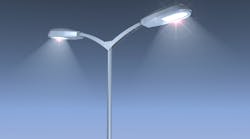Last year, DOE devoted two Postings and a webinar to the topic of LED street lighting and its potential effects on human health and the environment, in order to lay out reliable information in the wake of news stories generated by the American Medical Association's (AMA) community guidance on street lighting. EC&M also covered the topic in "LED Blues" in October of last year. The news stories have continued, and it's clear that as discussion of these issues has become more widespread, so have many misperceptions and mischaracterizations of the technical information, with the difference between what has and hasn't been scientifically established often blurred well beyond the squinting point.
So to redress the balance, DOE has assembled a list of helpful resources, including Frequently Asked Questions (FAQs) that look at the matter in considerable depth, providing accurate and useful information to the discussion and clarifying the state of scientific understanding as it presently exists.
A quick clarification is needed from the start. We hear much discussion about the health effects of "blue" light, but reference to that particular color is really being used as simple shorthand for a broad range of wavelengths that exert varying levels of influence on health. Because the relevant wavelengths for most effects actually extend beyond any generally accepted definition of "blue" on either end of its associated spectrum, we instead favor the term "short-wavelength" light. To put a finer point on it, wavelengths, rather than specific colors, are responsible for the biological (and other) effects that are the focus of current concerns.
Present in sunlight, short-wavelength light is a fundamental component of the natural environment. Ongoing medical research has demonstrated the ability of some of these wavelengths to stimulate biological responses, such as affecting circadian rhythm (the 24-hour biological clock). Because of the rise in the use of LEDs for outdoor lighting applications, and their relatively higher content of short wavelengths compared to the high-pressure sodium (HPS) products they typically replace, the concern is that a potential for greater exposure to those wavelengths at night may ultimately be detrimental to health.
However, all light at night can potentially contribute to the biological responses and related health concerns raised by the AMA. White light sources have a greater potential ability to stimulate those responses than non-white sources, but none of the factors or concerns are unique to LEDs. At any given wavelength and intensity, there's no difference between light emitted by an LED and that emitted by another type of light source. All nominally white light sources used for street lighting (mercury vapor, metal halide, fluorescent, induction, LED) have spectral power distributions (SPDs) with a greater proportion in short wavelengths than does the non-white HPS lighting that's been the dominant type for street and roadway lighting for the last several decades.
What's more, short wavelengths are a fundamental component of the visible spectrum and have their benefits, ranging from aesthetics to safety. White light sources containing short wavelengths render colors outdoors at night more naturally for human vision, aid in identification of people and objects, and improve contrast between an object and its background. Short wavelengths are also acknowledged to provide enhanced peripheral vision at the low levels of illuminance typically associated with street lighting. And it stands to reason that improved visual performance can bring associated safety benefits, which are a significant tradeoff when eliminated and often get short shrift in the ongoing debate. All this is not to say, however, that there aren't applications where the benefits of omitting the blue wavelengths outweigh any detriments from doing so. But unlike most conventional light sources, LEDs lend themselves especially well to engineering the spectral content to precisely match the need, whatever it may be.
Another complicating factor is that SPDs with very different component wavelengths can produce the same CCT, which makes CCT only a rough gauge of the actual spectral content of a given light source. This in turn also means that CCT is only an approximate gauge of the potential health and visibility influences of a light source. Although it roughly tracks with short-wavelength content (with higher CCT usually corresponding to a higher content of short wavelengths, and vice versa), the individual SPDs of different light sources vary enough that CCT is not a reliable indicator of the specific wavelength content. For example, there are some 4,000K LED light sources that are actually lower in short-wavelength content than some 2,700K LED sources (or, for that matter, than a 2,800K incandescent source — see the FAQs). Again, the issues under discussion are associated with specific wavelengths, not with colors.
Although some of the media coverage has given the impression that LED street lighting is the cause of the issues being raised, in fact it offers key solutions to those issues. That's because, unlike conventional street lighting, LED systems can be adjusted to provide only the level of illumination needed at any given time, and when well-designed they also offer a high degree of control over the direction in which light is emitted, which makes it much easier to reduce glare, light trespass, and uplight. This improved control also means that an LED streetlight can often meet the illumination requirement with just half of the lumens of the conventional system it replaces. All of this offsets much of the effects from any increased short-wavelength content in the LEDs — and may even more than offset those effects. But mention of this is typically neglected in most news stories.



